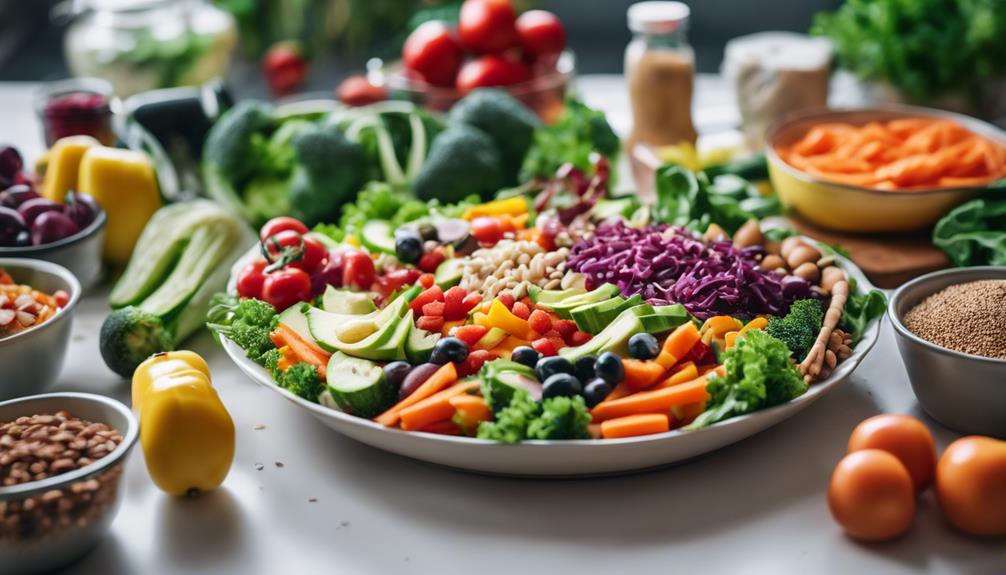When making Emma’s Clean Out the Fridge Salad, gather romaine lettuce, blanched broccoli, avocado, pistachios, and feta cheese. Chop the lettuce, dice the avocado, and assemble with nuts and cheese. Make a balsamic tarragon vinaigrette for a tangy finish. Customize with fruits, protein like grilled chicken, or Dijon mustard. Using leftovers doesn’t just reduce waste, but also boosts creativity and sustainability. Garnish with herbs, colorful vegetables, and unique dishes for an attractive presentation. Store produce in sealed containers, pre-cut for convenience, and keep nuts refrigerated. Keep meal components ready for quick assembly. Explore more for additional insights into this versatile dish.
Key Takeaways
- Use leftover ingredients like romaine, broccoli, avocado, pistachios, and feta for a flavorful salad.
- Customize with fruits, protein like grilled chicken, or grains for added variety.
- Reduce food waste, save money, and promote sustainability by utilizing leftovers.
- Enhance flavor with a balsamic tarragon vinaigrette dressing and Dijon mustard variations.
- Improve presentation with fresh herbs, colorful veggies, and unique serving dishes.
Ingredients for Emma's Clean Out the Fridge Salad
In Emma's Clean Out the Fridge Salad, you'll need romaine lettuce, blanched broccoli, avocado, pistachios, and feta for a fresh and nutritious mix.
To start preparing this versatile dish, grab a large bowl and begin by tearing the romaine lettuce into bite-sized pieces.
Next, add in the blanched broccoli florets for a satisfying crunch.
Then, carefully dice the avocado and sprinkle it over the greens.
For an added layer of flavor and texture, toss in a handful of pistachios and crumble some feta cheese on top.
Step-by-Step Salad Preparation Instructions

Chop the romaine lettuce and blanch the broccoli to establish the base for your Clean Out the Fridge Salad. These steps will guarantee a fresh and crisp foundation for your dish. As you prepare your salad, consider the following table to guide you through the process:
| Step | Instructions | Time Required |
|---|---|---|
| 1. Chop Lettuce | Wash and chop the romaine lettuce into bite-sized pieces. | 5 minutes |
| 2. Blanch Broccoli | Boil water, blanch broccoli for 2 minutes, then place in ice water to stop cooking. | 10 minutes |
| 3. Prepare Dressing | Whisk together balsamic tarragon vinaigrette with a hint of olive oil for a flavorful dressing. | 5 minutes |
| 4. Assemble Ingredients | Combine lettuce, blanched broccoli, avocado slices, pistachios, and feta cheese in a large bowl. Drizzle dressing over the salad. | 5 minutes |
Following these simple steps will result in a delicious and vibrant Clean Out the Fridge Salad ready to be enjoyed.
Tips for Customizing Your Salad

To elevate your salad experience, consider making ingredient substitutions and additions to customize your Clean Out the Fridge Salad. Swap out traditional ingredients like spinach for romaine lettuce or almonds for pistachios to add a new twist to your salad.
Experiment with adding fruits such as berries or apples for a touch of sweetness. Enhance the protein content by incorporating options like grilled chicken, tofu, or chickpeas, making your salad more satisfying and nutritious.
When it comes to the dressing, try mixing in Dijon mustard for a tangy kick. Explore different herbs and spices like cilantro or cumin to infuse unique flavors into your salad.
Additionally, consider adding grains such as quinoa or farro to introduce a variety of textures and extra nutrients to your dish. By customizing your salad with these simple yet impactful changes, you can create a fresh and versatile meal that suits your preferences and helps reduce food waste.
Benefits of Using Leftover Ingredients

Repurposing leftover ingredients in your meals not only reduces food waste but also adds depth and richness to your dishes. Utilizing ingredients from last night's dinner can transform a mundane salad into a culinary masterpiece. By incorporating these leftovers, you not only contribute to a more sustainable approach to cooking but also reveal a world of creative possibilities in the kitchen.
Here are some benefits of using leftover ingredients in your meals:
| Benefits of Using Leftover Ingredients | ||
|---|---|---|
| 1. Reduces food waste | 2. Saves money | 3. Adds variety and flavor |
| 4. Sparks creativity | 5. Promotes sustainability |
Serving Suggestions and Presentation Ideas

When serving your 'Clean Out the Fridge Salad', consider garnishing with fresh herbs for a burst of flavor.
Enhance the visual appeal by adding colorful veggies to your dish.
Utilize unique serving dishes to elevate the presentation and impress your guests.
Garnish With Herbs
Enhance your Clean Out the Fridge Salad by garnishing it with an assortment of fresh herbs for added color and flavor.
When it comes to utilizing fresh herbs as a garnish, consider the following suggestions:
- Mix and Match: Combine different herbs like parsley, cilantro, dill, or basil to create a harmonious blend of flavors that complement your salad ingredients.
- Chopped to Perfection: Opt for finely chopped herbs to sprinkle on top of your salad, not only enhancing its visual appeal but also infusing it with a delightful fragrance.
- From Garden to Plate: Utilize freshly picked herbs from your own garden or purchase them from a local market to guarantee the highest quality and freshness.
- Attention to Detail: Using herbs as a garnish showcases your attention to detail and enhances the overall dining experience for yourself and your guests.
Add Colorful Veggies
To create a visually appealing and appetizing salad, consider incorporating an array of colorful veggies like cherry tomatoes, bell peppers, and purple cabbage. These vibrant vegetables not only add a pop of color but also bring a variety of flavors and nutrients to your dish.
Enhance the visual appeal further by adding thinly sliced radishes, shredded carrots, and yellow squash, creating a vibrant and inviting salad presentation. For an extra dose of color and nutrition, dice some red onions, orange bell peppers, and golden beets to sprinkle over your salad. These colorful veggies not only make your dish visually appealing but also pack a nutrient-rich punch.
Garnish your salad with fresh herbs like parsley, cilantro, and chives to add a finishing touch of color and elevate the overall aesthetic. Experiment with different vegetable combinations to create a visually striking and appetizing dish that will impress your guests and elevate your dining experience.
Use Unique Serving Dishes
Consider incorporating unique serving dishes to elevate the presentation of Emma's Clean Out the Fridge Salad and impress your guests with a touch of creativity.
Next time you prepare this salad, try these serving suggestions:
- Serve the salad in individual mason jars for a trendy and portable presentation that allows guests to enjoy their own portion without the need for additional plates.
- Elevate the salad by arranging it in hollowed-out avocado halves, providing a visually appealing and eco-friendly option that adds a touch of elegance to the dish.
- Opt for rustic wooden boards or slate platters to showcase the vibrant colors and textures of the salad ingredients, creating a visually stunning display.
- Experiment with edible bowls made from Parmesan cheese crisps to add a crunchy and unique element to the dish, offering a creative twist on traditional serving methods.
Storage and Meal Prep Tips

When it comes to storing your fresh produce and ingredients, proper organization in the fridge is key to maintaining their quality. By following food preservation guidelines and implementing meal prep strategies, you can extend the shelf life of your items and reduce food waste.
Let's explore some effective ways to store and prepare your ingredients for a delicious and sustainable meal.
Fridge Organization Tips
Separate fruits and vegetables in designated drawers to maintain freshness and prevent premature spoilage in your fridge.
Here are some fridge organization tips:
- Utilize airtight containers: Store chopped vegetables in airtight containers or resealable bags to keep them fresh for longer periods and make meal prep more convenient.
- Label containers: Label containers with the date of preparation to monitor freshness and avoid consuming spoiled food, ensuring you always have access to safe and quality ingredients.
- Designate a meal prep shelf: Allocate a specific shelf in your fridge for meal prep ingredients to streamline cooking processes and reduce food waste by easily locating necessary items.
- Regularly clean and organize: Maintain a clean and organized fridge by regularly cleaning out expired items and ensuring visibility of all ingredients to prevent overcrowding and facilitate efficient meal planning.
Food Preservation Ideas
To effectively maintain the freshness and quality of your food items, implement smart storage and meal prep techniques that extend the shelf life of your ingredients.
Store fresh produce such as lettuce, broccoli, and avocado in airtight containers or resealable bags to help uphold freshness and prevent wilting.
Pre-cutting vegetables and fruits for easy access and quick meal prep can reduce food waste when making salads or stir-fries.
Utilize the blanching technique for broccoli to extend its shelf life while preserving its vibrant green color and crisp texture.
Keep nuts like pistachios in a cool, dry place or in the refrigerator to prevent them from going rancid and maintain their crunchiness.
For dairy products like feta cheese, store them in a brine solution or airtight container in the refrigerator to maintain their flavor and prevent spoilage.
Meal Prep Strategies
Consider storing your romaine lettuce and blanched broccoli in separate airtight containers with paper towels to maintain their freshness by absorbing excess moisture.
Avocados can be kept in the refrigerator once ripe to slow down ripening or frozen for future use in smoothies or dressings.
To preserve the crunchiness of pistachios, store them in a cool, dark place in a sealed container away from moisture.
Feta cheese remains fresh when stored in its original packaging with brine or crumbled in a resealable bag with a paper towel to absorb moisture.
When meal prepping, it's helpful to prepare individual salad components in advance, such as washing and chopping lettuce. This approach streamlines meal prep, providing a quick and healthy option readily available.
For dressings or sauces, using a blender or food processor can help achieve a smoother consistency, ensuring all ingredients are well combined for a delicious final touch to your salad.
Frequently Asked Questions
Can I Use Canned Instead of Fresh Ingredients?
Yes, you can use canned ingredients instead of fresh ones. They offer convenience and a longer shelf life. Just be mindful of any added sodium or preservatives. Canned options can work well in various recipes.
How Long Does the Salad Stay Fresh?
You should refrigerate the salad in an airtight container. It stays fresh for about 2-3 days. Remember to toss it gently before serving. Enjoy the flavors while they're at their best!
Can I Make This Salad Ahead of Time?
Sure, you could make it in advance, but where's the fun in that? Freshness might take a hit, but go ahead, prep it beforehand. Just promise to savor the flavors when you finally dig in.
Is This Salad Suitable for a Vegan Diet?
Yes, the salad is suitable for a vegan diet. It's packed with fresh veggies, grains, and legumes, making it a nutritious and satisfying option. You can easily customize it to fit your taste preferences and dietary needs.
Can I Add Cooked Proteins to the Salad?
Sure, you can definitely add cooked proteins to the salad to enhance its flavor and make it more satisfying. Just make sure they complement the veggies well for a balanced and delicious meal.
What Makes a Salad Fresh and Versatile versus Fresh and Flavorful?
When it comes to a fresh flavorful cobb salad recipe, the key is in the ingredients. Freshness is essential for a versatile and flavorful salad. Using crisp, colorful vegetables, high-quality proteins, and flavorful dressings can make all the difference in creating a salad that is both fresh and delicious.
Conclusion
To sum up, Emma's Clean Out the Fridge Salad is a versatile and invigorating dish that allows you to creatively use leftover ingredients.
Just like a painter uses a blank canvas to create a masterpiece, you can turn your fridge's contents into a culinary work of art.
So next time you find yourself with odds and ends in the fridge, remember the endless possibilities of Emma's salad recipe.
Enjoy the process of transforming simple ingredients into a delicious and satisfying meal.










